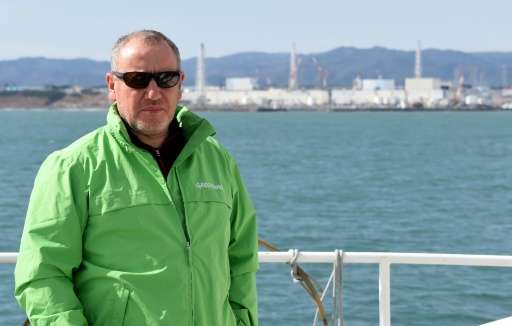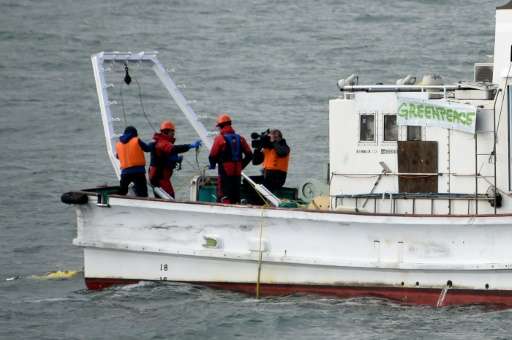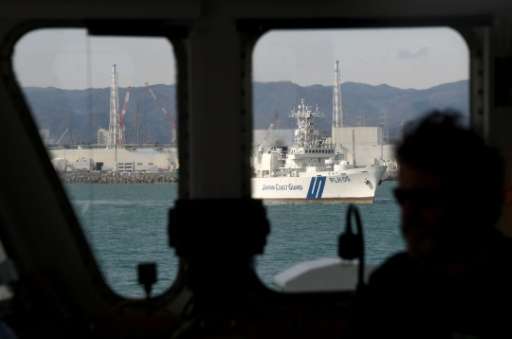Nuclear water: Fukushima still faces contamination crisis

Fish market vendor Satoshi Nakano knows which fish caught in the radiation tainted sea off the Fukushima coast should be kept away from dinner tables.
Yet five years after the worst nuclear accident since Chernobyl there is still no consensus on the true extent of the damage—exacerbating consumer fears about what is safe to eat.
Environmentalists are at odds with authorities, warning the huge amounts of radiation that seeped into coastal waters after a powerful tsunami caused a meltdown at the Fukushima Daiichi nuclear power plant on March 11, 2011, could cause problems for decades.
The Japanese government is confident it has stemmed the flow of radioactive water into the ocean, but campaigners insist contaminated ground water has continued to seep into the Pacific Ocean, and the situation needs further investigation.
"It was the single largest release of radioactivity to the marine environment in history," Greenpeace nuclear expert Shaun Burnie told AFP on the deck of the campaign group's flagship Rainbow Warrior, which has sailed in to support a three-week marine survey of the area the environmental watchdog is conducting.
Fukushima is facing an "enormous nuclear water crisis," Burnie warned.

He added: "The whole idea that this accident happened five years ago and that Fukushima and Japan have moved on is completely wrong."
Safe to eat?
Existing contamination means fishermen are banned from operating within a 20-kilometre (12.4-mile) radius from the plant.
Although there are no figures for attitudes on seafood alone, the latest official survey by the government's Consumer Affairs Agency showed in September that more than 17 percent of Japanese are reluctant to eat food from Fukushima.
Nakano knows it's best for business to carefully consider the type of seafood he sells, in the hope it will quell consumer fears.
"High levels of radioactivity are usually detected in fish that move little and stick to the seabed. I am not an expert, but I think those kinds of fish suck up the dirt of the ocean floor," he told AFP from his hometown of Onahama by the sea.
Greenpeace is surveying waters near the Fukushima plant, dredging up sediment from the ocean floor to check both for radiation "hotspots" as well as places that are not contaminated.

On Monday, the Rainbow Warrior sailed within a mile (1.6 kilometres) of the Fukushima coast as part of the project—the third such test it's conducted but the closest to the plant since the nuclear accident.
Researchers Tuesday sent down a remote-controlled vehicle attached with a camera and scoop, in order to take samples from the seabed, which will then be analysed in independent laboratories in Japan and France.
"It's very important (to see) where is more contaminated and where is less or even almost not contaminated," Greenpeace's Jan Vande Putte told AFP, stressing the importance of such findings for the fishing industry.
Local fishermen have put coastal catches on the market after thorough testing, which includes placing certain specimens seen as high risk through radiation screening—a programme Greenpeace lauds as one of the most advanced in the world.
The tests make sure no fish containing more than half of the government safety standard for radiation goes onto the market.
Under control
The 2011 disaster was caused by a magnitude 9.0 undersea earthquake off Japan's northeastern coast which then sparked a massive tsunami that swamped cooling systems and triggered reactor meltdowns at the Fukushima Daiichi plant, run by operator Tokyo Electric Power (TEPCO).
Today, about 1,000 huge tanks for storing contaminated water occupy large parts of the site, but as 400 tonnes of groundwater a day flows into the damaged reactor buildings, many more will be needed.
TEPCO have said they are taking measures to stop water flowing into the site, including building an underground wall, freezing the land itself and syphoning underground water.
The government too insist the situation is under control.
"The impact of the contaminated water is completely contained inside the port of the Fukushima plant," Tsuyoshi Takagi, the Cabinet minister in charge of disaster reconstruction, told reporters on Tuesday.
But Greenpeace's Burnie says stopping the groundwater flow is crucial to protecting the region.
"What impact is this having on the local ecology and the marine life, which is going on over years, decades?", Burnie asked.
He added: "We can come back in 50 years and still be talking about radiological problems" at the nuclear plant as well as along the coast, he said.
© 2016 AFP



















